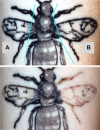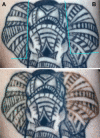Increased Tattoo Fading in a Single Laser Tattoo Removal Session Enabled by a Rapid Acoustic Pulse Device: A Prospective Clinical Trial
- PMID: 31536162
- PMCID: PMC7003736
- DOI: 10.1002/lsm.23163
Increased Tattoo Fading in a Single Laser Tattoo Removal Session Enabled by a Rapid Acoustic Pulse Device: A Prospective Clinical Trial
Abstract
Background and objectives: The ability to provide improved tattoo fading using multiple laser passes in a single office laser tattoo removal session is limited. In part, this is due to the loss of laser effectiveness caused by epidermal and dermal vacuole "whitening" generated during the initial laser pass at the tattoo site. The Rapid Acoustic Pulse (RAP) device generates acoustic shock wave pulses that clear epidermal and dermal vacuoles to enable multiple laser passes in a single office laser tattoo removal session. The objectives of this study were to determine if the RAP device, when used as an accessory to the 1064 nm Nd:YAG Q-switched (QS) laser can enable delivery of multiple laser passes in a single office laser tattoo removal session, and therefore result in increased tattoo fading compared to the clinical standard single-pass QS laser tattoo removal session.
Study design/materials and methods: The RAP device was evaluated in a single-center (SkinCare Physicians), prospective, IRB approved study. A total of 32 black ink tattoos, from 21 participants, were divided into three zones and treated with either multiple QS laser passes, each followed by 1 minute of RAP device application (Laser + RAP) in zone one and single-pass QS laser treatment (Laser-Only) in zone two, separated by an untreated control zone. The treatment sites were assessed for the number of laser passes and adverse events immediately, 6 weeks, and 12 weeks following the treatment session. Photographs of the treatment sites were assessed for percent fading at 12 weeks post-treatment by three blinded reviewers.
Results: When the RAP device was applied as an accessory to the QS laser in a multi-pass laser tattoo removal treatment, an average of 4.2 laser passes were delivered in a single session, with no unexpected or serious RAP device-related adverse events. At the 12-week follow-up, tattoos treated with Laser + RAP showed a statistically significant increase in average fading (44.2%) compared with tattoos treated with Laser-Only (24.8%) (P < 0.01). Additionally, a significantly higher overall proportion of tattoos treated with Laser + RAP (37.5%) had a response of >50% fading compared with tattoos treated with QS Laser-Only (9.4%) (P < 0.01) as well as a response of >75% fading from Laser + RAP treatment (21.9%) compared with Laser-Only treatment (3.1%) (P < 0.05).
Conclusions: The RAP device, applied as an accessory to the 1064 nm Nd:YAG QS laser, safely enables multiple QS laser treatments in a single office laser tattoo removal session by clearing the whitening caused by the previous QS laser pass. Enabling multiple QS laser passes results in a statistically significant increase in tattoo fading in a single office laser tattoo removal session compared to the clinical standard single-pass QS laser tattoo removal session. © 2019 The Authors. Lasers in Surgery and Medicine Published by Wiley Periodicals, Inc.
Keywords: Q-switched laser; acoustic pulse; acoustic shock wave; tattoo removal.
© 2019 The Authors. Lasers in Surgery and Medicine Published by Wiley Periodicals, Inc.
Figures











Similar articles
-
Accelerated tattoo removal with acoustic shock wave therapy in conjunction with a picosecond laser.Lasers Surg Med. 2018 Sep;50(9):890-892. doi: 10.1002/lsm.22945. Epub 2018 Jun 25. Lasers Surg Med. 2018. PMID: 29938802
-
Topical perfluorodecalin resolves immediate whitening reactions and allows rapid effective multiple pass treatment of tattoos.Lasers Surg Med. 2013 Feb;45(2):76-80. doi: 10.1002/lsm.22106. Epub 2012 Dec 19. Lasers Surg Med. 2013. PMID: 23255145 Clinical Trial.
-
A rapid tattoo removal technique using a combination of pulsed Er:YAG and Q-Switched Nd:YAG in a split lesion protocol.J Cosmet Laser Ther. 2015;17(4):177-83. doi: 10.3109/14764172.2015.1007066. Epub 2015 Feb 20. J Cosmet Laser Ther. 2015. PMID: 25588039 Clinical Trial.
-
Lasers for the treatment of eyebrow microblading and cosmetic tattoo pigment: a review of the literature.Lasers Med Sci. 2023 Nov 7;38(1):256. doi: 10.1007/s10103-023-03921-z. Lasers Med Sci. 2023. PMID: 37932517 Review.
-
Laser removal of tattoos.Am J Clin Dermatol. 2001;2(1):21-5. doi: 10.2165/00128071-200102010-00004. Am J Clin Dermatol. 2001. PMID: 11702617 Review.
Cited by
-
Lasers treatment for traumatic facial tattoo.Lasers Med Sci. 2022 Dec 29;38(1):28. doi: 10.1007/s10103-022-03658-1. Lasers Med Sci. 2022. PMID: 36580127 Free PMC article.
References
-
- Laumann AE, Derick AJ. Tattoos and body piercings in the United States: A national data set. J Am Acad Dermatol 2006;55(3):413–421. - PubMed
-
- Armstrong M, Roberts A, Owen D, Koch J. Contemporary college students and body piercing. J Adolesc Health 2004;35(1):58–61. - PubMed
-
- Ibrahim O, Kaminer M. Accelerated tattoo removal facilitated with acoustic wave device: delivering up to 90% fading in a single office visit. American Society for Laser and Medicine and Surgery Annual Conference Late‐Breaking Abstracts #LB18. Lasers Surg Med 2017;49:411.
-
- Vangipuram R, Hamill SS, Friedman PM. Accelerated tattoo removal with acoustic shock wave therapy in conjunction with a picosecond laser. Lasers Surg Med 2018;50:890–892. - PubMed
Publication types
MeSH terms
LinkOut - more resources
Full Text Sources

